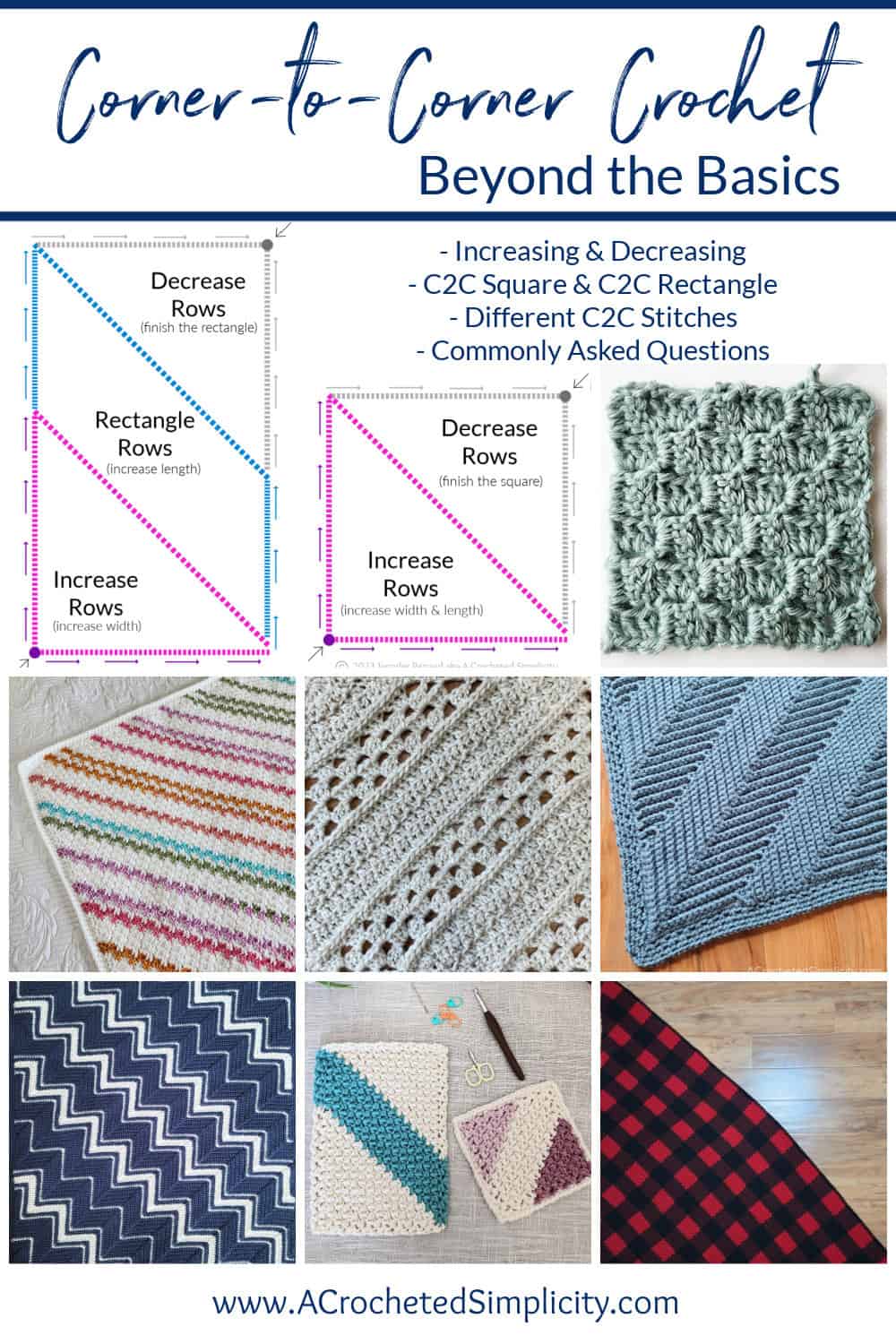How to Corner-to-Corner Crochet (C2C Crochet): Beyond the Basics
Do you want to learn all about corner-to-corner crochet (C2C Crochet)? It has been a wildly popular crochet technique for the past several years, but what exactly is this technique?
What kind of projects can I create with C2C crochet?
What are the different crochet stitches I can crochet C2C?
In this corner to corner crochet article, you’ll learn the answers to these questions and more as we dive in and go beyond the basics!
CORNER TO CORNER CROCHET
After you’ve mastered a few basic crochet skills, corner to corner crochet (abbreviated as C2C) is a fun technique every crocheter should learn and add to their crochet toolbox.
You’ll also see this technique referred to as:
- C2C Crochet
- working “On the Bias”
Even though corner to corner crochet is a simple crochet technique, the projects you can create with it are AMAZING!
Corner to Corner Crochet in a Nutshell
What is corner to corner C2C crochet technique?
For all C2C crochet projects, you’ll begin your crochet project in one corner and crochet your rows diagonally, increasing at both ends (think triangle), until your project is the desired width. Then begin decreasing each row at both ends, until you’ve reached the corner opposite to the one you started.
This simple method is how to crochet a C2C square. See the graphic below for a visual.
You can also make a corner to corner crochet rectangle beginning with the same simple method. But to make a C2C rectangle, you’ll work one more simple section before beginning to work decreases. I’ll explain more below.
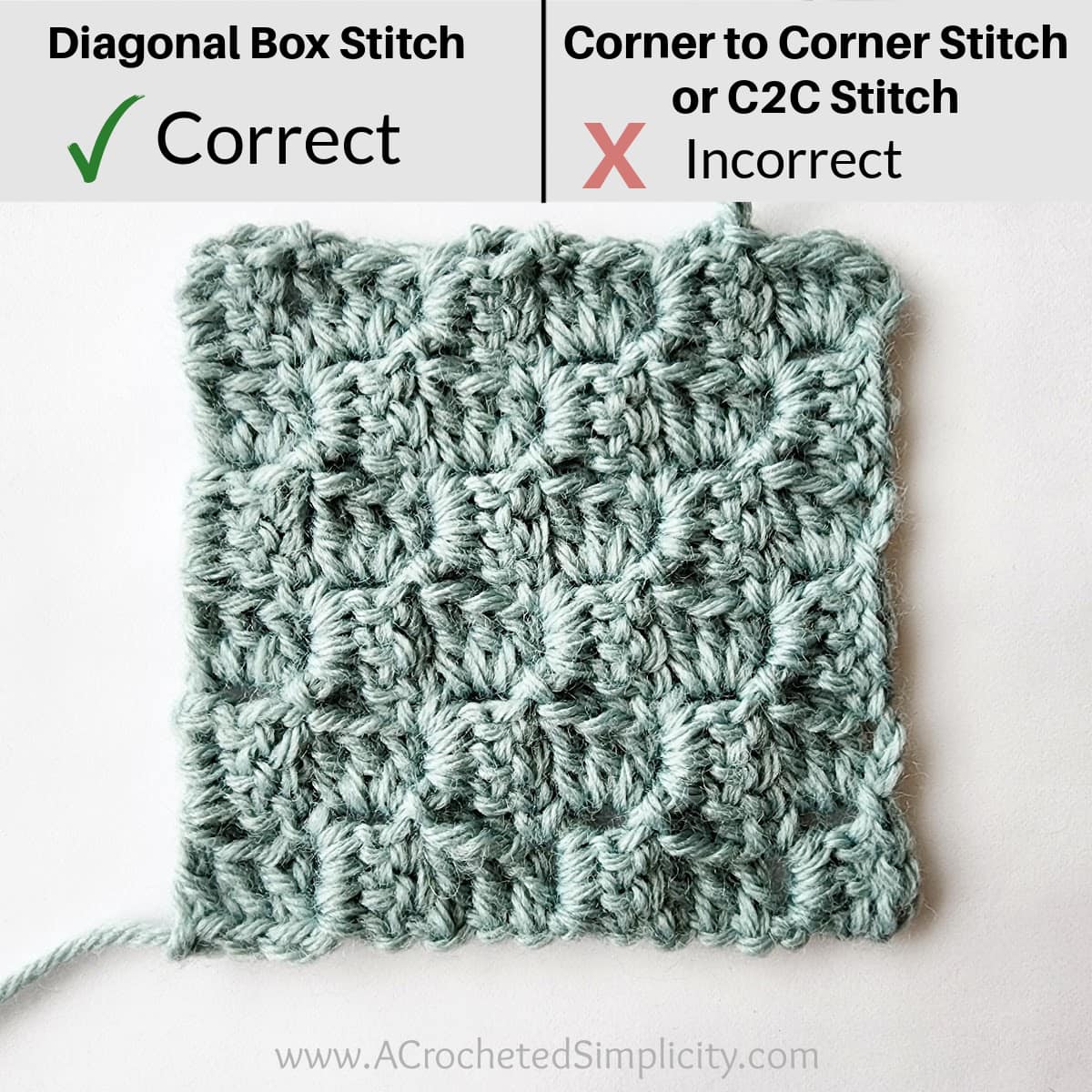
Corner to Corner Stitch – C2C Stitch
In the crochet community, the diagonal box stitch is commonly referred to as the C2C or Corner to Corner stitch, but this is incorrect. The diagonal box stitch is simply one of many stitch patterns that can be worked from corner to corner.
The crochet diagonal box stitch has been, by far, the most popular stitch pattern worked on the bias for the past several years. I’m sure you’ve seen it used to create blankets, accessories, and other various projects with charts and colorwork.
Learn Crochet Corner to Corner for Beginners (link coming soon), using the diagonal box stitch, in my step-by-step photo tutorial. In this complete tutorial, you’ll learn how to create a C2C square, C2C rectangle, how to increase, decrease, and more.
Keep reading for a list of many different corner to corner crochet stitches and tutorials.
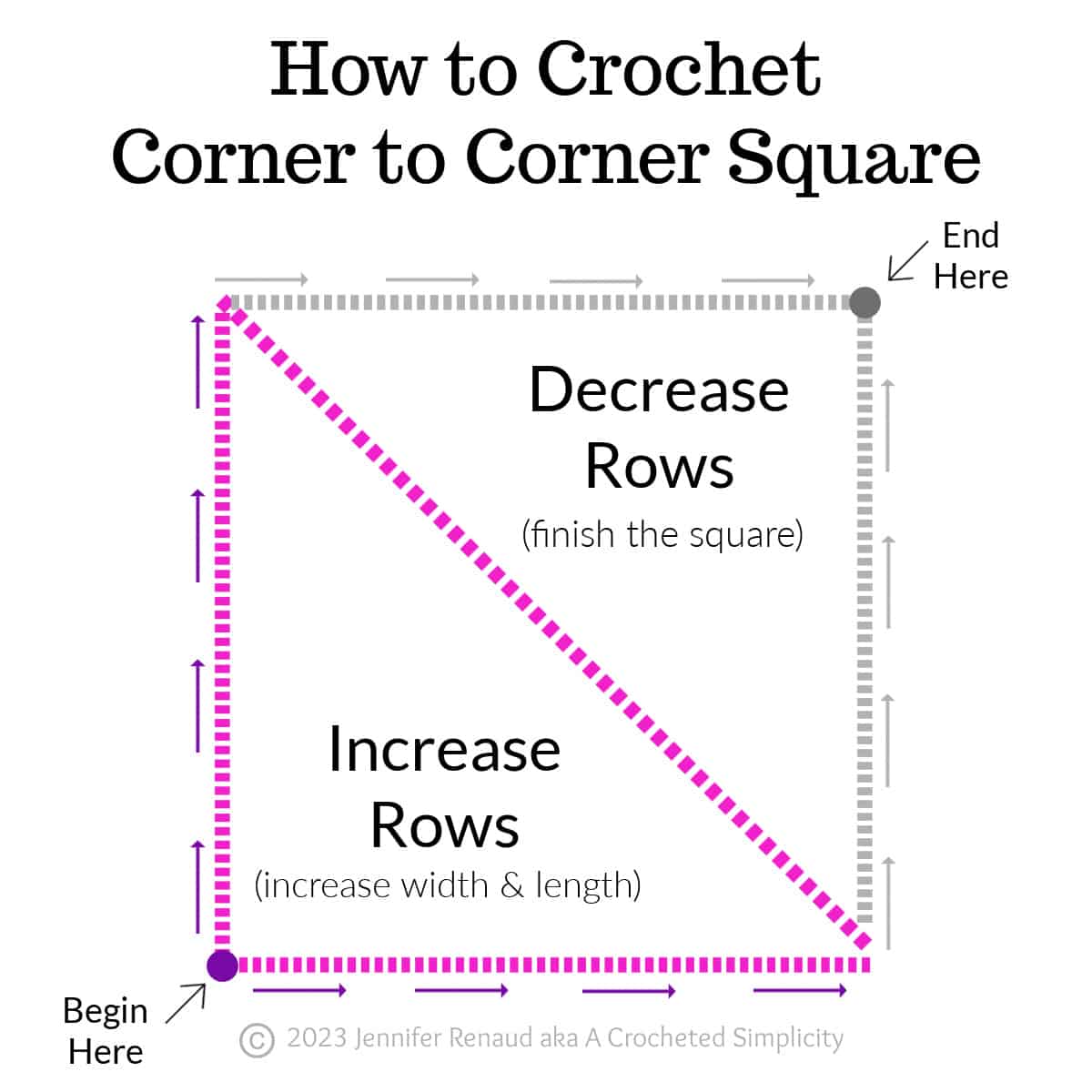
How to Crochet a C2C Square
If you are a beginner or just learning how to corner to corner crochet, a basic C2C square is a great place to start.
These 3 simple steps tell you how to make a square C2C blanket. *See the graphic above for a visual of these steps.
- Step 1: Begin your project in one corner and increase each row as you work diagonally (on the bias). Think *triangle*.
- Step 2: Continue to increase your work until you’ve reached the desired width.
- Increase Rows – Your stitch count will increase.
- Step 3: Lastly, begin decreasing both ends of each row until you reach the corner opposite the one you started with.
- Decrease Rows – Your stitch count will decrease.
Note: My graphics show beginning a C2C square and rectangle in the lower left corner and working to the upper right, but you can also begin in the lower right and work to the upper left. Just make sure to follow the instructions for the project you’re making.
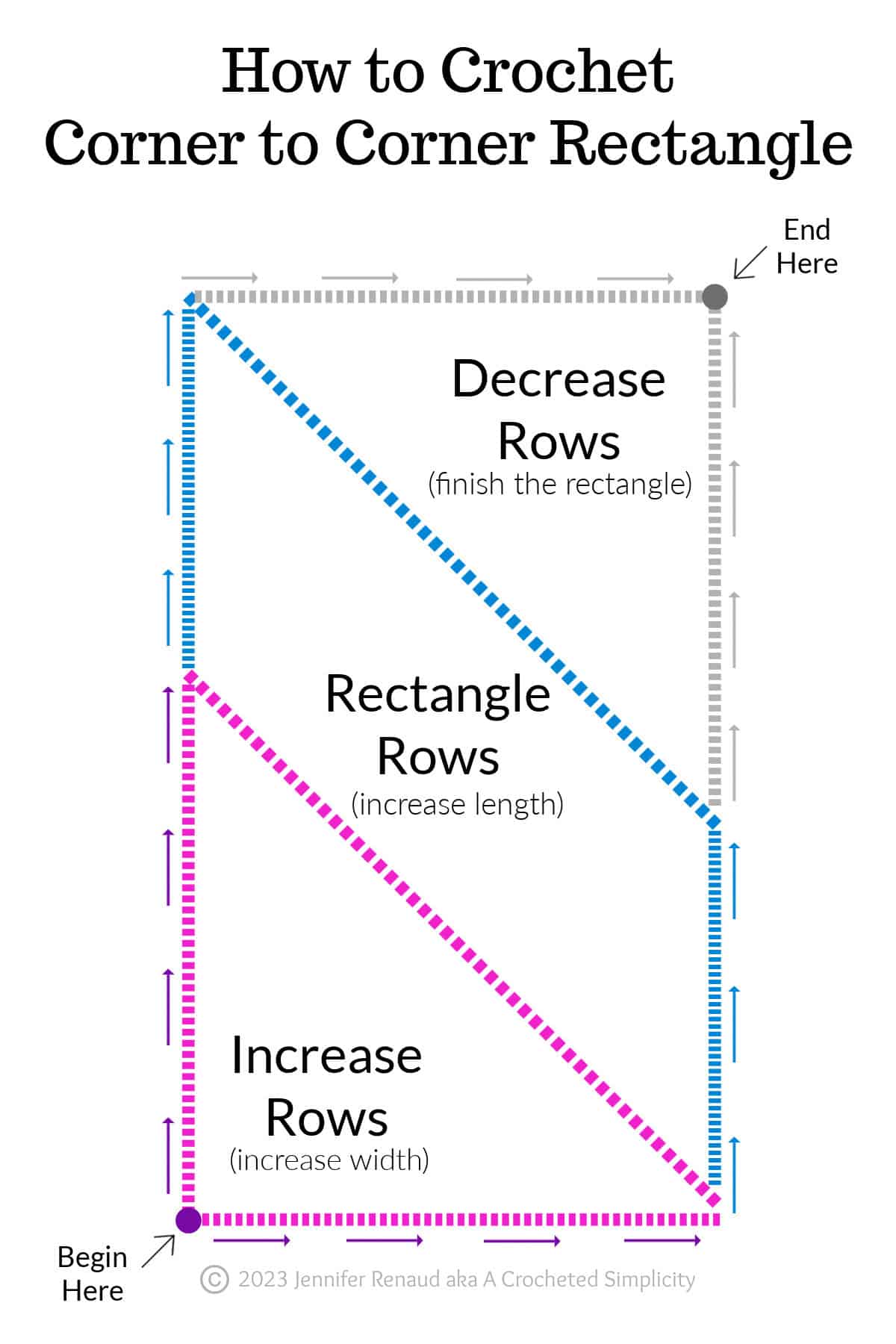
How to Crochet a C2C Rectangle
Does C2C crochet have to be square?
Absolutely not! In fact, I prefer a corner to corner crochet rectangle blanket over a C2C square blanket because they fit people better. We’re more rectangular shaped than square shaped. 😉
You’ll begin and end a C2C rectangle the same as a C2C square. You begin with an increase row section and end with a decrease row section. But when working a corner to corner crochet rectangle, there’s an extra section in the middle that I like to call the Rectangle Row section.
The rows in the Rectangle Row section will increase on one end of the row and decrease on the opposite end of the same row. Your stitch count in this section does not change. It will be the same as the stitch count for the last increase row you worked.
These 4 simple steps tell you how to make a rectangle C2C blanket or scarf. You can even make a rectangle pillow, or a panel for a cardigan. *See the graphic above for a visual of these steps.
- Step 1: Begin your project in one corner and increase each row as you crochet diagonally (on the bias). Think *triangle*.
- Step 2: Continue to increase your work until you’ve reached the desired width.
- Increase Rows – Your stitch count will increase.
- Step 3: Next, you’ll continue to increase one end of a row while decreasing the opposite end of the same row until you’ve reached the desired length.
- Rectangle Rows – Your stitch count does not change.
- Step 4: Lastly, you’ll begin decreasing both ends of each row until you reach the corner opposite to the one you started with.
- Decrease Rows – Your stitch count will decrease.
Corner to Corner Crochet Decrease
Crocheters often ask when to start decreasing and how to work a corner to corner crochet decrease.
You’ll start decreasing when your project reaches its intended size, or when it reaches its widest and tallest point.
But, how to work a corner to corner crochet decrease isn’t a one size fits all answer.
The crochet stitch or stitch pattern that you’re using for your C2C crochet project will determine how you work the decreases.
Most basic stitch patterns will decrease at the beginning and end of each row by working a standard decrease stitch (2 together).
For example, if you’re working a C2C blanket in single crochet, you will begin and end each decrease row with a sc2tog.
For more complex stitch patterns, you may simply skip stitches at the beginning and end of each row to decrease.
The corner to corner crochet pattern you are crocheting will specify how to work a C2C crochet decrease for that specific pattern.
Types of C2C Crochet Projects
Many ask “What can you make with C2C?”.
Blankets and afghans are the most popular C2C crochet projects, but cool weather accessories such as scarves, hats, and shawls are also fun to make.
You can also crochet a variety of other home decor items such as dishcloths, towels, rugs, pillows, and table runners.
What I LOVE About C2C Crochet Blankets
The best thing about C2C blankets is how easy it is to adjust the width and length of the blanket as you’re crocheting.
Even after you begin your blanket, you can decide to make your blanket wider or narrower without having to rip it all out, start over, and waste hours of your time!
I recently made my husband the C2C Crochet Buffalo Plaid Blanket. He’s 6′-1″ so a standard size lapghan or throw blanket wouldn’t be big enough for him.
And because I always second guess myself about how big to make blankets, it was great to be able to “try it on” him for size as I crocheted it. He now has a blanket that’s the perfect size for him!
How big should a C2C blanket be? A C2C blanket can be made any size from baby through California King. Refer to my Standard Blanket Size Chart for specific measurements.
Different Corner to Corner Crochet Stitches
What different crochet stitches can be used for C2C crochet?
Although, C2C crochet was made wildly popular with the diagonal box stitch, with a little stitch manipulation, any crochet stitch can be worked from corner to corner.
Aside from the diagonal box stitch, a few other stitches I’ve commonly seen worked corner to corner are the double crochet stitch, granny stitch, c2c single crochet, and the linen stitch (aka moss stitch), among others.
I’ve also worked less common stitch patterns corner to corner, such as the ripple stitch, griddle stitch (aka lemon peel stitch), extended moss stitch, and mini-bean stitch.
You’ll find examples of all of these different corner to corner stitches below.
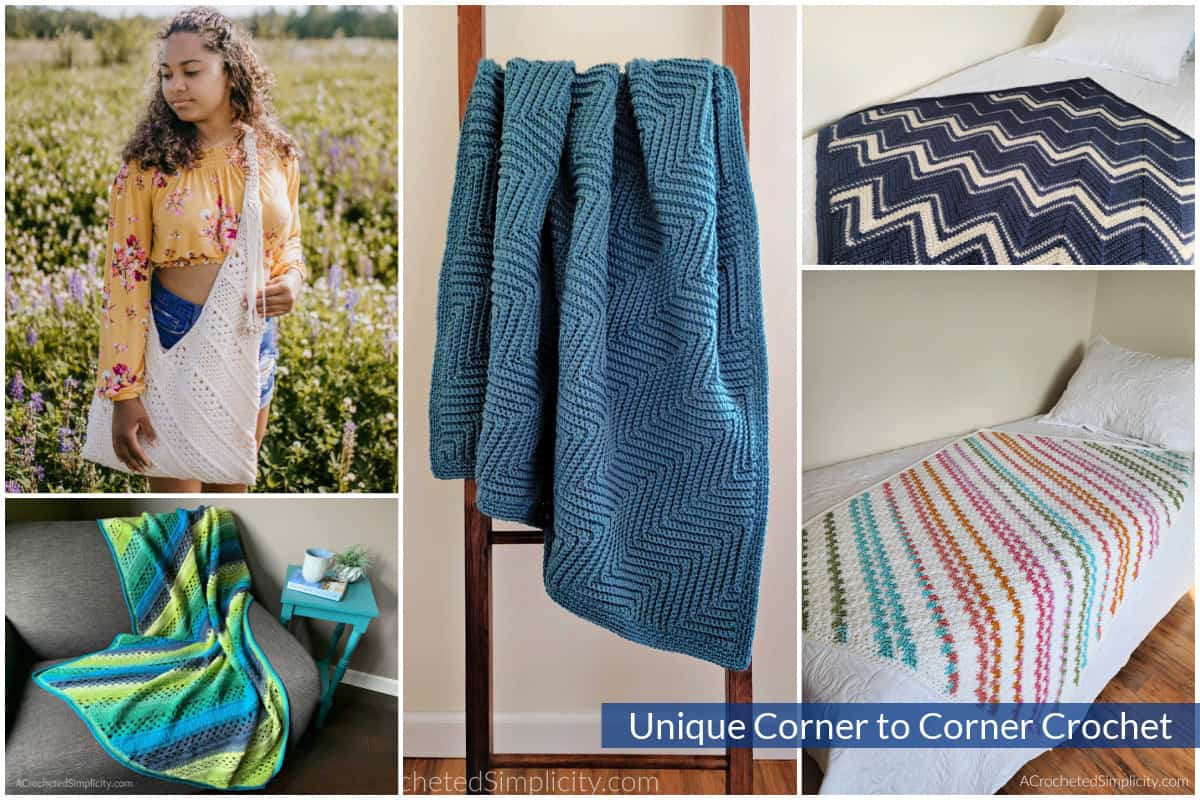
C2C Crochet Ideas You’ll Love
The diagonal box stitch creates a crochet fabric that resembles small blocks, which makes it perfect for crochet colorwork, such as the projects I designed for this C2C Accessories video class.
If you love making blankets with the crochet diagonal box stitch, check out my Caspian Crochet Blanket. Crochet a basic diagonal box stitch blanket on the bias and then add a classic ribbed border.
But there is a world out there of other deeply textured crochet stitches that create stunning corner to corner crochet variations!
I hope you’ll be inspired by one of the following corner to corner crochet patterns:
Many of the following free corner to corner crochet patterns include video tutorials.
- Learn how to crochet the diagonal single crochet ripple stitch in both the back loops only (BLO) and both loops. Both create beautiful blankets.
- The Diagonal Ripple Lapghan and Diagonal Ripple Scarf both use the single crochet ripple stitch worked in back loops only.
- The Diagonal Chevron Lapghan uses the single crochet chevron stitch worked in both loops.
- You can try this one on a smaller scale in my 12″ Diagonal Chevron Afghan Square.
- If you’re looking for a fun diagonal single crochet dishcloth, the C2C Crochet Dishcloth Pattern may peak your fancy.
- My On the Bias Rectangular Afghan and On the Bias Square Afghan use both the granny stitch and linen stitch in one design. Both of these corner to corner crochet blanket patterns include a video tutorial.
- If you love tote bags, you may love the On the Bias Tote Bag! It has the look of a C2C project, but it’s crocheted in rows.
- The Aubergine Afghan also combines the granny stitch with the linen stitch, but in a more unique way. This one is created using 4 rectangular panels that are seamed into a modern crochet blanket design.
- In my Traveling Afghan Crochet Square, I combined the granny stitch with a textured double crochet stitch pattern.
- When crocheting my Candy Stripes Lapghan, you’ll learn how to crochet the Extended Double Moss Stitch corner to corner and how to add diagonal stripes.
- My Cuddly Soft Baby Blanket is an easy corner to corner crochet baby blanket pattern that uses a simple, textured double crochet stitch.
- The C2C Buffalo Plaid Crochet Blanket is an easy crochet C2C blanket pattern that uses the griddle stitch (also known as the lemon peel stitch). The stitches are easy, but the colorwork may require a little concentration.
- Don’t like plaid? Use the same instructions (without the colorwork) to crochet a C2C griddle stitch blanket.
- Learn to crochet the Mini-Bean Stitch from corner to corner. This tutorial includes instructions to make either a square or rectangle. Use them to make a scarf, blanket, dishcloth, and more. I’m working on a fun baby blanket for a special little baby boy.
- The phone pocket on my latest Crochet Water Bottle Holder uses single crochet worked diagonally, or C2C single crochet.
- Last, but definitely not least, is my On the Bias Granny Square Afghan. One simple crochet square design can be arranged to create 6 different looking afghans! This is one of my premium crochet patterns and can be found on Ravelry & Etsy (aff).
Save this crochet article to Pinterest so you can reference it later!
Questions Crocheters Frequently Ask About Corner-to-Corner Crochet (C2C)
In addition to questions I’ve answered in this article above, below are some commonly asked questions about corner-to-corner crochet.
What is C2C Crochet?
The technique of working corner to corner crochet is very simple. Choose any crochet stitch, begin your project in one corner and crochet on the bias (on a diagonal… think *triangle*), increasing each row, until your project is the desired width and length. Then, decrease each row until you’ve reached the corner opposite the one you started.
What does C2C mean?
C2C is the standard abbreviation for corner to corner crochet.
Is corner to corner crochet hard?
Absolutely not! If you can crochet basic stitches, and you know how to work simple crochet increases and decreases, you can crochet corner to corner. Beginners can learn corner to corner crochet.
What is a C2C stitch in crochet?
You’ll often hear others refer to a C2C stitch in crochet. Crocheters call the diagonal box stitch the C2C stitch. This is incorrect! There is no specific C2C stitch. C2C is a crochet technique, not a stitch.
How to decrease corner to corner crochet?
To decrease in corner to corner crochet, you will work decrease stitches at the beginning and end of each row. If you’re making a C2C single crochet blanket, you will work a sc2tog at the beginning and end of each decrease row.
Follow the corner to corner crochet written instructions for working the decreases in your specific project.
Is corner to corner crochet always square?
Absolutely not! As you’ve read above, you can make a C2C square and a C2C rectangle. You can also make a C2C triangle for a triangular shawl.
What yarn to use for C2C crochet?
The most common yarn weights used for C2C crochet are DK and worsted weight yarns. Most crocheters prefer to use worsted weight yarns to make a corner to corner crochet blanket. Worsted weight and DK weight yarns also make fabulous C2C cardigans.
If you’re planning to make a graphgan with a lot of colorwork, I recommend choosing a yarn that has a large variety of colors. This way you’ll be using the same yarn line throughout your project and your gauge will stay consistent.
What is the best stitch for C2C?
In my opinion, there is no right answer to this question. It really depends on your project. The diagonal box stitch is great for making graphgans (charted afghans with a picture), but I love using classic crochet stitches such as the granny stitch crochet and moss stitch crochet. I also love textured crochet stitch patterns such as the griddle stitch and mini-bean stitch.
I have too many favorites!
How do you avoid gaps in C2C crochet? How do I make my C2C tighter?
This question is typically asked when crocheting a C2C project with the diagonal box stitch. Each block consists of 3 double crochet and a chain 3. The chain 3 can make your project appear a little holey.
There are two ways to help avoid gaps in your diagonal box stitch projects.
- Work your ch-3 tightly, or
- Instead of a chain 3, work a chain 2. If you choose to use a ch-2 instead, then you’ll begin an increase row with a ch-5 instead of a ch-6. This is also referred to as the C2C 5 2 method.
How to change colors in corner to corner crochet?
Weaving in ends isn’t my favorite pastime, so I rarely do colorwork in C2C crochet. I prefer to add stripes or colorblock sections to my corner to corner projects, or I’ll choose a self-striping yarn with long color changes, like the Lion Brand Mandala family.
In my C2C Buffalo Plaid Blanket, I changed colors on the last pull through of a stitch. And in my Candy Stripes C2C Blanket, I worked color changes the same way, but I only changed colors at the end of a row.
I’m likely the minority here, but when I’m working corner to corner crochet colorwork with the diagonal box stitch, I prefer to change colors when slip stitching into the next ch-2 or ch-3 space. I believe it creates a neater color change. Most crocheters prefer to change colors on the last pull through of the 3rd dc (or hdc) of a block.
How do you edge corner to corner in crochet?
When I edge a corner to corner blanket, I like to work a round of single crochet, adding three single crochet stitches in each corner.
When adding an edge to a diagonal box stitch C2C blanket, I add three single crochet (sc) in each corner and I work 2 single crochet stitches into each horizontal double crochet (dc) block and 1 single crochet into each vertical double crochet.
If you want to add a wider crochet border to your C2C project, simply repeat rounds of crochet stitches, adding 3 stitches to each corner to keep them from curling. You can add a simple single crochet border, or use any taller stitch to create a wider border.
How to finish a C2C blanket?
I like to add a border to all of my crochet blankets. First, I add a round of single crochet, working three single crochet in each corner so my corners don’t curl. Then I’ll add a simple border such as 3 – 4 more rounds of single crochet. I also love the look of a ribbed border on crochet blankets.
Check out my Caspian Crochet Blanket where I share two C2C crochet border options.
What is the difference between C2C and mini-C2C?
When you hear others referring to a C2C and mini-C2C, again, they’re usually referring to the diagonal box stitch. Typically, when speaking of C2C, they’re referring to the diagonal box stitch using double crochet stitches and ch-3’s. When speaking of a mini-C2C, they’re referring to the diagonal box stitch using half double crochet (hdc) stitches and ch-2’s.
If you have any questions that I haven’t answered above, always feel free to reach out to me, (e-mail me: ACrochetedSimplicity at Gmail dot Com), and I’ll do my best to help!
I hope I’ve inspired you with several new C2C crochet ideas.
JOIN US IN THE FACEBOOK COMMUNITY GROUP!
Come share your finished projects with us in the A Crocheted Simplicity Crochet Community Group on Facebook. Join us for fun community events such as crochet alongs, join in on crochet conversations, ask questions, get advice, and share your love for crochet!



